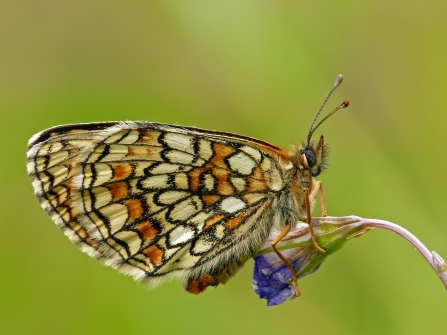Numbers have been increasing steadily over the last few years, but this year has seen a bumper surge in sightings and distribution of the butterflies around the reserve.
On the brink of extinction during the 1970s, careful habitat management and warmer temperatures has given rise to the growing number of butterflies at this south Essex reserve. Only found flitting around close to the ground from May to July at a handful of sites in England, Heath Fritillary are restricted to specialised habitats, preferring sunny, warm and sheltered environments. Colonies of this delicate brown and orange butterfly occupy sheltered heathland in the south west of England and coppiced woodland in the south east of England where their larval food plant, Common cow-wheat is present.
A team of dedicated volunteers has been supporting the staff at Essex Wildlife Trust to continuously manage areas of their ancient woodland reserve to make it the best possible habitat for one of the UK’s rarest butterflies. The ideal habitat for Heath Fritillary consists of a mixture of bare ground, leaf litter and taller vegetation, providing areas for shelter, perching, feeding and laying their eggs. To create this, volunteers have worked tirelessly removing bramble to encourage the food plant and have helped coppice the woodland; a traditional method of woodland management which involves cutting a tree or shrub to ground level, resulting in regeneration of new stems from the base. They have also assisted with the creation of scallops; curved edges along the woodland with a gradual transition from grassy habitats to mature trees which creates varied habitat, encourages growth of potential nectar resources and disrupts wind flow to ease the butterfly’s flight. This habitat maintenance must be maintained year on year so that the reserve remains butterfly friendly.
The mild weather over the past couple of years coupled with careful habitat management has resulted in the population of this lovely butterfly significantly strengthen over the past couple of years. It is really great to see this after a number of years of extremely low numbers and it goes to show the fantastic habitat creation and maintenance work that the volunteers have been helping to create is really paying off!
Emerging in May, a peak count of 148 Heath Fritillary butterflies was recorded during June this year, more than double recorded the year before and the highest number recorded since the summer of 2010. The butterflies were recorded in newly created scallops and coppiced areas this year which means their distribution has increased throughout the site. This is vital for the continued existence of the species on the reserve and a positive result of the careful habitat management.

